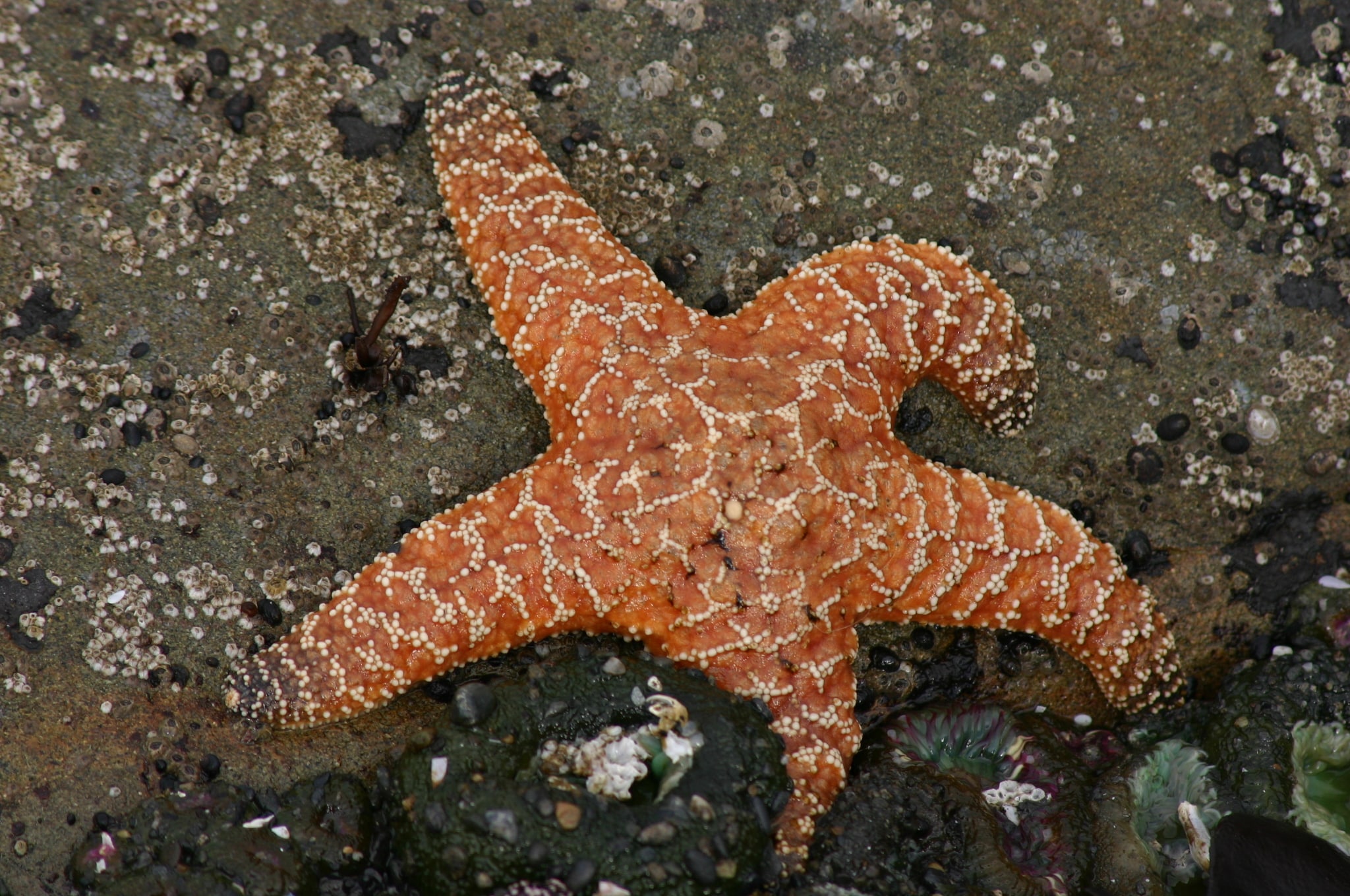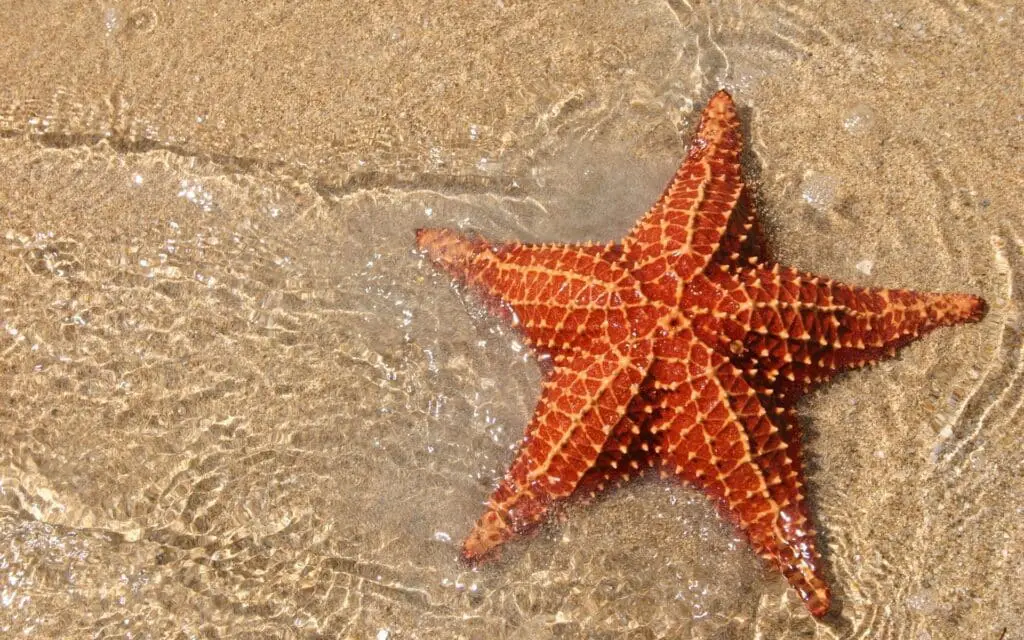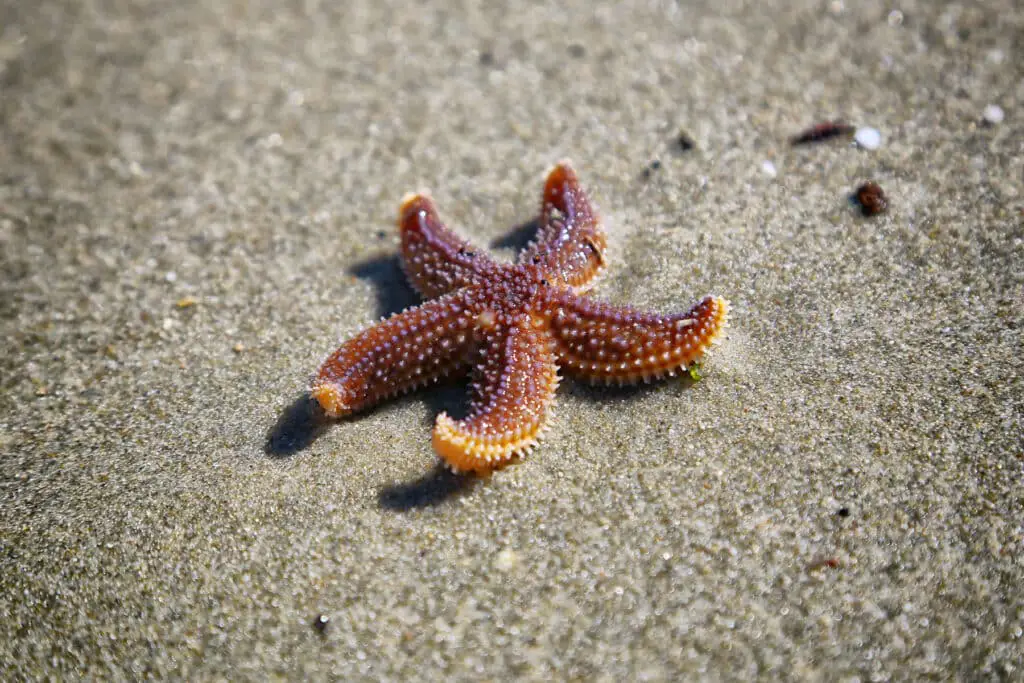What Animals Eat Starfish

Introduction
What Animals Eat Starfish: In the intricate tapestry of marine ecosystems, the dietary habits of various animals often take center stage, showcasing the remarkable interplay of predator and prey. Among the diverse array of oceanic delicacies, the humble starfish has earned its place as both hunter and hunted.
Starfish, also known as sea stars, may appear slow-moving and defenseless, but they are anything but passive. These fascinating echinoderms are found in oceans across the globe, from shallow coastal waters to the deep abyssal plains. While they might not be the top pick for every oceanic carnivore, there are indeed creatures with an appetite for these unique invertebrates.
One of the notable starfish predators is the sea otter. These adorable marine mammals, found along the coasts of North America, have a penchant for cracking open the calcareous shells of various marine creatures, including starfish, using their impressive dexterity. Sea otters are particularly fond of the tasty purple sea urchins but won’t pass up a starfish snack when it’s on the menu.
In addition to sea otters, some fish species, like the triggerfish, are known to relish starfish as part of their diet. The oceanic ecosystem’s intricate web of life demonstrates the remarkable adaptability and survival strategies that have evolved in response to the ever-shifting dynamics of nature.

Do sharks eat starfish?
Only sharks that swim near the bottom of the sea eat starfish. Some are :Nurse sharks, Horn Sharks and Port Jackson Sharks. All of these sharks have strong enough jaws to crush the hard bony outer skeleton of the starfish and eat the flesh underneath.
Sharks are renowned predators of the ocean, but their diet primarily consists of fish, seals, marine mammals, and sometimes even other sharks. While sharks have a reputation for consuming a wide range of marine life, they are not typically known to feed on starfish as a significant part of their diet.
Sharks are carnivorous creatures with a keen sense of smell and are often opportunistic hunters. They are more likely to target animals that provide a higher energy return for their efforts, such as fish or seals, which are rich in calories and nutrients. Starfish, on the other hand, have a tough and calcareous exoskeleton that can be difficult for most sharks to digest.
However, there are exceptions to every rule in nature. In extremely rare cases, some shark species might ingest a starfish if it happens to come across one and there are no other food sources available. Nonetheless, this is not a common occurrence, and it certainly doesn’t make starfish a staple in a shark’s diet.
While sharks are formidable predators of the sea, their dietary preferences typically exclude starfish. Sharks tend to focus on prey that offers greater nutritional value and are better suited to their hunting capabilities, leaving starfish to coexist with other marine life in the vast and diverse ocean ecosystem.
Are starfish eaten by anything?
Their ability to cling to rocks with suction-cup-like feet and their hard exoskeletons make them difficult to find and eat for most other creatures, but starfish do have several predators. Sharks, manta rays, Alaskan king crabs and even other starfish prey upon them.
Starfish, also known as sea stars, serve as prey for a variety of marine animals in their respective ecosystems. While they have a unique and distinctive appearance, they are not invulnerable, and several creatures have adapted to include them in their diet.
One of the most well-known starfish predators is the sea otter. These agile marine mammals are skilled hunters, using their dexterous paws to pry open the starfish’s calcareous exoskeleton and feast on the soft tissues within. Sea otters are particularly partial to species like the purple sea urchin and are known to consume starfish when other food sources are scarce.
Certain fish species also include starfish in their diet. Triggerfish, for example, possess strong jaws and teeth that can crush the starfish’s protective shell, allowing them access to the nutritious tissues inside. Additionally, some crab species and certain types of sea birds have been observed feeding on starfish.
While starfish have a range of natural predators, their ability to regenerate lost limbs and even their entire bodies is a remarkable defense mechanism. If a starfish loses an arm to a predator, it can often grow a new one, ensuring its survival in the face of predation.
What do starfish eat with?
Sea stars eat mussels and clams and other things with hard shells. But they don’t have teeth to crush those shells. Instead, they combine tube feet with that stomach-barfing feeding mode. Tube feet are like the suckers you see on an octopus arm.
Starfish, also known as sea stars, have a unique and interesting way of feeding. They are opportunistic carnivores and are equipped with a specialized feeding method that allows them to consume a variety of prey in their underwater habitats.
The underside of a starfish is covered with numerous tube feet, which are equipped with tiny suction cups. These tube feet are used for a dual purpose: locomotion and feeding. When it comes to capturing and eating prey, starfish use their tube feet to slowly approach their target. Once they are within reach, they extend their tube feet to envelop the prey.
Starfish primarily feed on bivalves (such as clams and mussels), snails, small fish, and detritus (dead plant and animal matter). When they encounter a bivalve, they use their tube feet to pry the shell open, revealing the soft flesh inside. The stomach of the starfish then everts (turns inside out) through its mouth, which is located in the center of its underside.
What crab eats starfish?
The red decorator crab
“The red decorator crab – or Schizophrys aspera – was by far the most consistent predator consuming COTS in 89 per cent of the feeding trials,” Ms Desbiens said.
Several species of crabs are known to include starfish in their diet, and they play a significant role in controlling starfish populations in various marine ecosystems. Some of these starfish-eating crabs include the following:
- Velvet Swimming Crab (Necora puber): These crabs are found in the North Atlantic Ocean and are known to feed on a variety of prey, including starfish. They have strong claws that allow them to crush the calcareous shells of starfish and access their soft tissues.
- Green Crab (Carcinus maenas): Green crabs are an invasive species in many parts of the world, and they are opportunistic feeders. They are known to consume a wide range of marine organisms, including starfish.
- Puget Sound King Crab (Lopholithodes mandtii): This large and powerful crab is native to the North Pacific Ocean, and it is known to feed on a variety of bottom-dwelling creatures, including starfish.
- Arrow Crab (Stenorhynchus seticornis): Found in tropical and subtropical waters, arrow crabs are known to feed on small starfish and other invertebrates. They have long, slender legs and a pointed body shape.
- Decorator Crabs: Various species of decorator crabs, such as the camouflaged crab (Xantho poressa), are known to attach bits of their environment to their carapace for camouflage. In some cases, they may adorn themselves with bits of starfish, indicating that they may consume them.
Can dolphins eat starfish?
Some of the inshore species such as bottlenose dolphins eat fish, squid, cuttlefish, eels, and even prawns and starfish.
Dolphins are carnivorous marine mammals with a diverse diet that primarily includes fish, squid, and crustaceans. While they are not typically known to feed on starfish as a significant part of their diet, there have been rare instances where dolphins have been observed consuming starfish.
Dolphins are highly intelligent and opportunistic predators, and their specific dietary preferences can vary depending on their geographic location, available prey, and individual preferences. In some regions, where starfish are abundant and easily accessible, dolphins may occasionally consume them. However, this behavior is not common and varies among dolphin species.
It’s important to note that dolphins have evolved to hunt prey that provides them with a substantial source of energy and nutrients. Starfish have a calcareous exoskeleton that can be challenging to digest, and their nutritional value may not be as high as other prey items in the dolphins’ diet, such as fish and squid.
While dolphins have the ability to consume a wide range of marine life, including starfish, it is not a regular or prominent part of their diet. Dolphins primarily rely on more easily digestible and nutritionally valuable prey, making starfish a relatively uncommon choice in their menu.
What animals are known to eat starfish?
Several marine creatures, including certain fish, crustaceans, and some species of sea birds, are known to feed on starfish.
Several marine animals are known to include starfish in their diet, depending on their habitat and feeding habits. Some of the notable animals that are known to eat starfish include:
- Sea Otters: Sea otters are skilled hunters that use their dexterous paws to pry open the shells of various marine creatures, including starfish. They are particularly fond of the tasty purple sea urchins but will also consume starfish when available.
- Triggerfish: Certain species of triggerfish have powerful jaws and teeth that can crush the tough exoskeleton of starfish, allowing them to access the soft tissues inside.
- Some Fish Species: Several fish species, such as pufferfish and some wrasses, are known to feed on starfish, particularly smaller or juvenile individuals.
- Crabs: Some crab species, like the decorator crabs, may use bits of starfish for camouflage, suggesting that they may consume them on occasion.
- Sea Birds: Certain sea birds, like gulls, may feed on stranded or injured starfish along the shoreline.
- Other Echinoderms: Some echinoderms, such as certain species of sea cucumbers, may consume small starfish.
Starfish, with their unique appearance and calcium carbonate exoskeleton, can be both a challenging and valuable food source for some marine creatures, contributing to the intricate web of predator-prey relationships in the ocean.
Do any fish species specifically prey on starfish?
Yes, some species of triggerfish, pufferfish, and filefish are known to feed on starfish. They have specialized jaws and teeth adapted for consuming hard-shelled invertebrates like starfish.
While starfish are not typically a primary food source for most fish species, there are some fish that specifically prey on starfish as part of their diet. These fish have developed specialized adaptations that allow them to target and consume starfish. Here are a few examples:
- Pufferfish: Some species of pufferfish are known to feed on starfish. Pufferfish have strong beaks and powerful jaws that enable them to crush the calcareous exoskeleton of starfish and access the soft tissues inside.
- Harlequin Filefish: Harlequin filefish, found in coral reef ecosystems, are known to eat starfish, particularly the cushion starfish. They have a unique feeding behavior, using their specialized mouths to pick off and consume the tube feet of the starfish.
- Dragonets: Certain species of dragonets, like the red scooter dragonet, have been observed feeding on small starfish and other small invertebrates in reef environments. They have slender bodies and mouths designed for picking off small prey.
- Some Wrasse Species: In reef ecosystems, some wrasses, such as the yellow moon wrasse, may feed on small starfish as part of their diet. They use their sharp teeth to tear apart and consume the starfish.
Are there any predators that specifically target starfish?
Some sea stars, such as the crown-of-thorns starfish, are known to be predatory toward other starfish species. They can have significant impacts on coral reefs by consuming coral-reef-building species.
There are several predators that specifically target starfish as a significant part of their diet. These predators have evolved specialized adaptations to capture and consume starfish effectively. Some of these starfish-specific predators include:
- Sunflower Star (Pycnopodia helianthoides): This large and voracious sea star, also known as the sunflower sea star, primarily feeds on other species of starfish. It uses its numerous arms to engulf and consume its prey, including various types of smaller starfish.
- Leather Star (Dermasterias imbricata): Leather stars are known to feed on other starfish, particularly the sunflower starfish. They have a leathery texture and can effectively capture and consume their prey.
- Crown-of-Thorns Starfish (Acanthaster planci): These starfish are notorious for their coral-feeding habits and can decimate coral reefs. While their primary diet is coral polyps, they will also consume other starfish, making them significant predators of starfish in coral reef ecosystems.
- Some Sea Urchins: Certain species of sea urchins, such as the long-spined sea urchin, are known to graze on starfish, particularly if other food sources are limited. Their sharp spines help them capture and consume starfish.
- Some Predatory Snails: Certain species of predatory snails, like the Pacific triton snail (Charonia tritonis), are known to feed on starfish. They use their proboscis to bore through the starfish’s exoskeleton and feed on the soft tissues inside.
These predators play important roles in regulating starfish populations within their respective ecosystems. However, it’s worth noting that the impact of these predators on starfish populations can vary depending on factors like their abundance, the availability of other prey, and environmental conditions.

Conclusion
In the intricate tapestry of marine life, the dietary preferences of animals, including the consumption of starfish, offer a compelling glimpse into the complexity of oceanic ecosystems. While starfish may seem like passive, slow-moving creatures, they are indeed part of the predator-prey dynamic that shapes the underwater world.
Through our exploration of starfish predators, we’ve discovered some of the ocean’s most skilled hunters, such as sea otters and certain fish species. These creatures have evolved specialized adaptations to feed on starfish, from nimble paws that can crack open shells to sharp teeth that can tear through the starfish’s tough exoskeleton.
The interactions between starfish and their predators highlight the delicate balance that exists within marine ecosystems. When one species becomes too abundant, it can have cascading effects on the entire food web. For example, overpopulation of sea urchins, a favorite prey of sea otters, can lead to the destruction of kelp forests, impacting numerous other species.
As we reflect on what animals eat starfish, we gain a deeper appreciation for the intricacies of life beneath the waves. The ocean’s diverse inhabitants, from the seemingly immobile starfish to the voracious sea otters, contribute to the ever-evolving drama of survival and predation in the world’s oceans. Understanding these interactions is not only a testament to the wonders of nature but also crucial for preserving the health and balance of our marine environments.



